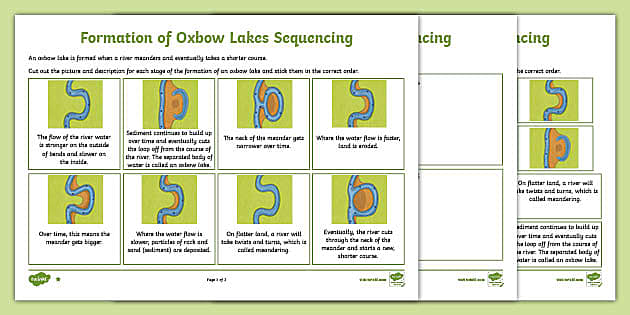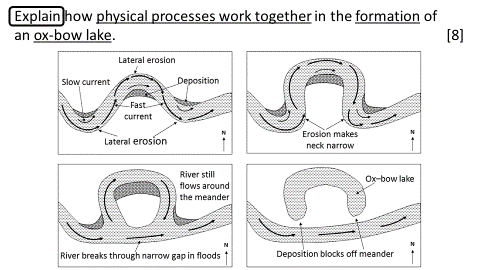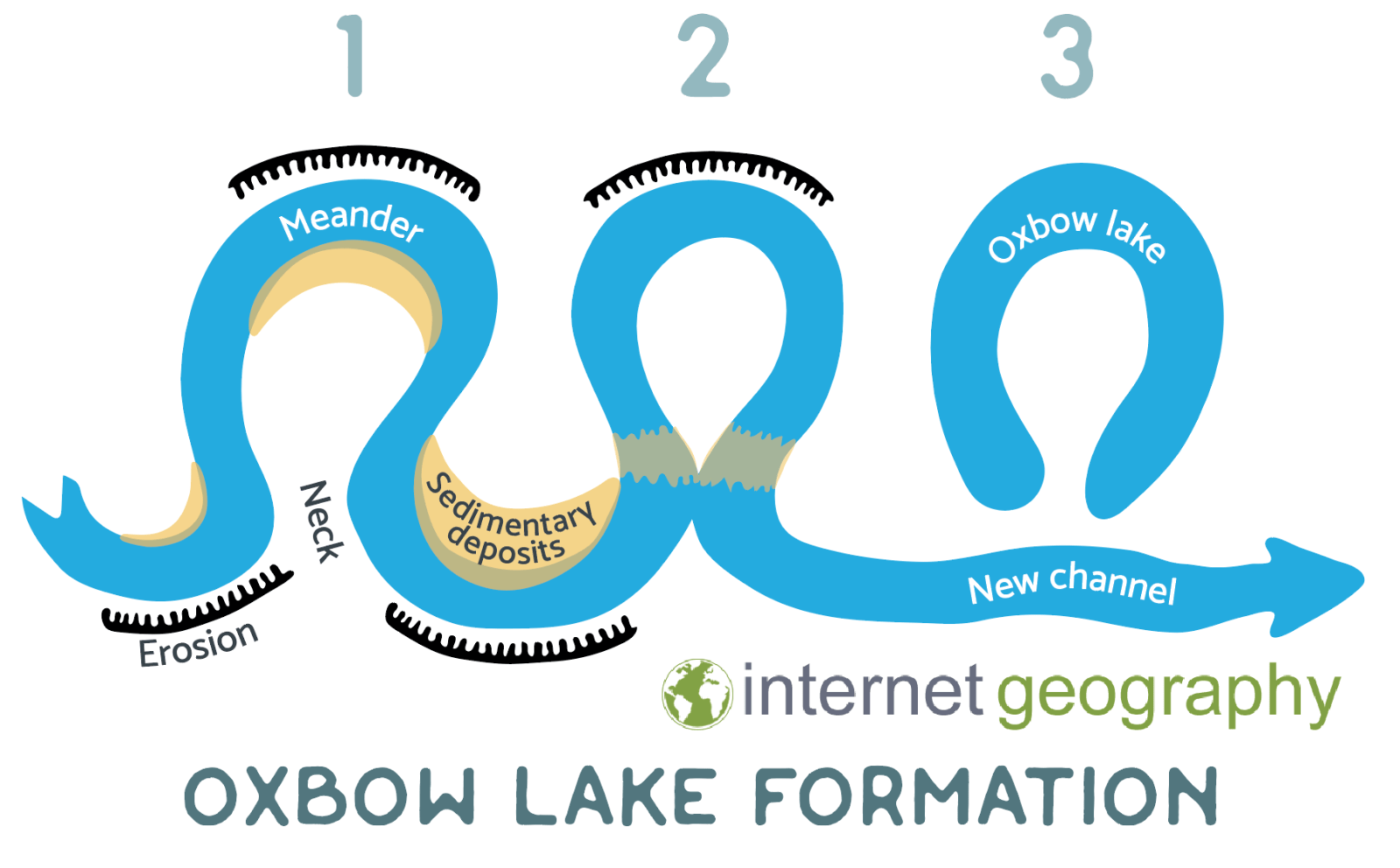Describe the Formation of an Oxbow Lake
They are formed from Meanders. The word oxbow can also refer to a U-shaped bend in a river or stream whether or not it is cut off from the main stream.

Ks2 Formation Of Oxbow Lakes Sequencing Activity
The banks of the curves closest to one another the concave banks are prone to erosion from the force.

. Oxbow lakes are U-shaped or curved bends in a river that are cut off from the main river flow forming a lake. When a meander or loop. Ox-bow lakes are found in the middle and lower course of the river where lateral erosion is significant.
An oxbow lake forms when a curve or meander in a river pinches shut. The formation begins with erosion at the meander neck this type of erosion is called hydraulic action. The formation of an oxbow lake is formed at a meander an example of this is the cuckmere river.
It is also actually and. They are features of both erosion and deposition. An oxbow lake is a U-shaped lake or pool that forms when a wide meander of a river is cut off creating a free-standing body of water.
Deposition occurs on the inner bend as a result of slower velocity forming a slip off slope. It is shaped like a crescent or the bow of an oxen yoke. Oxbow lakes are a curious geographic phenomenon that can be found in various countries around the world.
2 What important functions do deltas provide. An oxbow lake forms when the strip of land that seperates parts of a meander is eroded. Over a given period of time this process repeats until eventually the river becomes.
Oxbow lakes form through the following steps. Oxbow lake refers to the remnant part of the erstwhile meandering stream which has been cut off from the main channel due to the stream straightening process View the full answer Transcribed image text. 3 Explain some ways pollution could possibly contaminate aquifer systems.
Due to erosion on the outside of a bend and deposition on the inside the shape of a meander will change over a period of time. Learn how to define an oxbow lake explore how they are formed. Oxbow lake formation in a meandering stream.
Oxbow lakes form when a river has two curves one bending away from the straight course and another bending back. The meander neck also gets narrower as materials deposit and soon cuts off the bend. In Australia an oxbow lake is called a billabong from the indigenous Wiradjuri language.
The river follows a new shorter course and a lake forms beside the river. The formation begins with erosion at the meander neck this type of erosion is called hydraulic action. Phil Reiker NPS Geologic Resources Division.
In South Texas oxbows left by the Rio Grande are called resacas. In Australia oxbow lakes are called billabongs. An oxbow lake is a uniquely shaped lake resulting from the path of a meandering river.
5 What impacts could global warming have on the supply of fresh water. A river meanders because of obstacles and patterns of erosion and deposition of sediments. How do oxbow lakes form.
Most water is directed towards the outside bend there is also reduced friction and increased velocity. A meander is first formed as a result of deposition and erosion - velocity is higher on the outside bend which means erosion occurs forming a cliff face. As a river reaches flatter land it swings from side to side forming winding bends called meanders.
Conversely the inner bend of a river has lower velocity so sediment is deposited. A meandering stream has a single channel that winds snakelike through its valley so that the distance as the stream flows is greater than as the crow flies As water flows around these curves the outer edge of water is moving faster than the inner. An oxbow lake is a lake that forms when a meander in a river is cut off from the rest of the river.
This is the middle part of a rivers journey. How does an oxbow lake form. An oxbow lake forms when a meander or curve in the waters course gets cut off from the main river leaving a U-shaped lake behind.
Oxbow lakes are most commonly found in the middle course of the river where the river has more energy and higher discharge. 2 As river meanders become more pronounced and curved the two outside banks of one or two meanders may eventually. A Floodplain is a wide flat or nearly flat land over which the stream moves.
Meander a bend in a river 3. They are called oxbow lakes due to their curved shape which resembles a bow or horse-shoe shape. An oxbow also refers to the horseshoe-shaped bends in rivers that can eventually become oxbow lakes.
1 Describe the steps in the formation of an oxbow lake. Formation of erosional and depositional features in river landscapes. When you get a meander the lake slowly erodes from the inside because water will always want to take the faster route which would be straight the lake will slowly cute off the meander while dumping the rivers load forming an oxbow lake.
Explain the formation of an oxbow lake. The river is meandering across the valley and erodes laterally. This leaves the meander loop cut off as an oxbow lake.
An Oxbow lake is essentially formed when a meandering river has its flow cut off by sediment deposition. As the water erodes at the neck material deposits at the opposite point of erosion. The water flows fastest around the outside of the bend and slower on the inside.
This landform is so named for its distinctive curved shape which resembles the bow pin of an oxbow. Flooding in 1877 formed Carter Lake in Iowa an oxbow of the Missouri River. Question 19 5 pts Describe and explain the formation of an oxbow lake on a stream floodplain.
This lake is eventually filled by sediment through river flooding. When the tightly curved portion of the stream is cut off an oxbow lake develops off from the main river system. Erosion narrows the neck of the land within the meander and as the process continues the meanders move closer together.
Meander Ox-bow lake Deposition Erosion 2. An oxbow lake is a U-shaped lake that forms when a wide meander of a river is cut off creating a free-standing body of water. Oxbow Lakes Meander neck becomes smaller new course of the river oxbow lake When the river floods it breaks through the thin meander neck and the river takes the easier straight course.
The lakes are formed by what were once bends or large curves in winding river systems and as such can be found in groupings in some areas. The speed of the flow cuts away the outside bank of a loop in a process called erosion. 1 Rivers meander because of the processes of erosion and deposition where sediments are taken away from the bank of.
The Outer bend of a river is where the velocity of the river flow is highest hence the bank is eroded away. FORMATION OF OX-BOW LAKES. The formation of an oxbow lake is formed at a meander an example of this is the cuckmere river.
4 What are some possible problems associated with the use of water in agriculture. Migrating streams erode the landscape.

Draw A Simple Diagram To Show The Formation Of An Oxbow Lake Internet Geography

No comments for "Describe the Formation of an Oxbow Lake"
Post a Comment